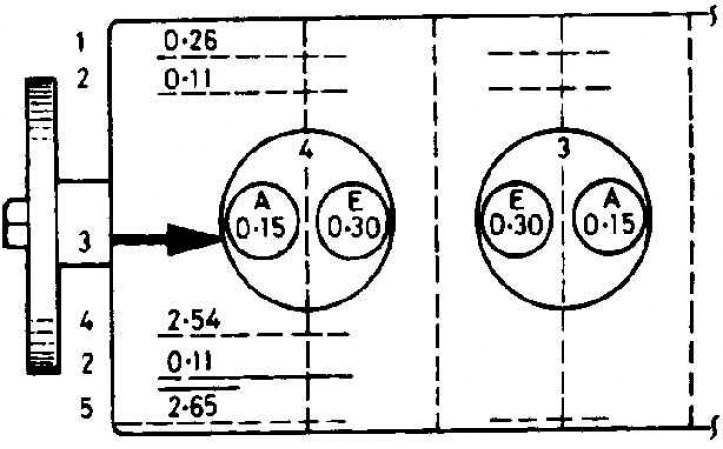Valve shim thickness calculation

A. Inlet valve; E. Exhaust valve
1. Measured clearance; 2. The difference between 1 and 3; 3. Normal clearance; 4. The thickness of the installed shim; 5. Calculated thickness of the new shim
Examination
1. Checking the valve adjustment must be done after the appearance of valve knocking, overhaul of the engine or when the engine power is reduced. Check and adjust on a cold engine.
2. Apply the handbrake, raise the front of the vehicle and remove the right front wheel.
3. Remove the plastic fender guard to access the crankshaft pulley bolt.
4. Turn the crankshaft by the pulley mounting bolt until the holes in the pulley and cylinder block are aligned and block the pulley with an adjusting rod. To facilitate turning the crankshaft, unscrew the fuel injectors.
5. Remove the cylinder head cover.
6. Draw a diagram of the engine and number the cylinders from 1 to 4. Cylinder 1 is on the transmission side. On each cylinder draw inlet and outlet valves. Above each cylinder in the figure, draw two horizontal lines. On line #1, record the actual clearance of all valves, and on line #2, the amount by which the clearance must be changed to obtain the required clearance.
7. Turn the crankshaft until the inlet valve of cylinder 1 is completely closed, i.e. the camshaft lobe on this valve must point upwards.
8. Using a feeler gauge, measure the clearance between the cam base and the follower. Record the actual clearance on line #1 opposite the appropriate valve.
9. Repeat the measurement for the remaining seven valves, turning the crankshaft as necessary so that the cam of the valve being tested is pointing up.
10. Calculate the difference between actual and required clearance and record on line #2.
11. If all clearances are within specification, install cylinder head cover, install plastic cover under fender, install wheel and lower vehicle. If the actual clearance is not within specification, adjustment must be made.
Adjustment
1. Remove the distributor.
2. Remove the first pushrod from the head and remove the shim from the top of the valve. Wipe the shim thoroughly and measure its thickness with a micrometer. Shims are usually marked, but their thickness may decrease due to wear.
3. Referring to measurements of valve clearances, it is necessary to determine the thickness of the new shim. If the actual valve clearance was greater than required, then the thickness of the shim must be increased by the amount recorded on line #2 opposite the corresponding valve. If the actual valve clearance was less than required, then the thickness of the shim should be reduced by the amount recorded on line #2 opposite the corresponding valve.
4. In the figure, draw three horizontal lines below each valve. On line #4, write down the measured shim thickness, then add or subtract the value recorded on line #2. The result is the thickness of the gasket that must be set to obtain optimum valve clearance. It must be written on line number 5.
5. Repeat the operation to select a new adjusting plate for the remaining valves.
6. When installing a new gasket, install with the markings facing down. From above on an adjusting lining establish pushers.
7. Install the camshaft and re-measure the valve clearance.
